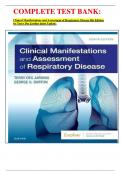COMPLETE TEST BANK:
Clinical Manifestations and Assessment of Respiratory Disease 8th Edition
by Terry Des Jardins latest Update.
,Chapter 01: The Patient Interview
Des Jardins: Clinical Manifestations And Assessment Of Respiratory Disease, 8th
Edition
Multiple Choice
1. The Respiratory Care Practitioner Is Conducting A Patient Interview. The Main Purpose Of
This Interview Is To:
a. Review Data With The Patient.
b. Gather Subjective Data From The Patient.
c. Gather Objective Data From The Patient.
d. Fill Out The History Form Or Checklist.
Ans: B
The Interview Is A Meeting Between The Respiratory Care Practitioner And The Patient. It Allows The
Collection Of Subjective Data About The Patient’s Feelings Regarding His/Her
Condition. The History Should Be Done Before The Interview. Although Data Can Be
Reviewed, That Is Not The Primary Purpose Of The Interview.
2. For There To Be A Successful Interview, The Respiratory Therapist Must:
a. Provide Leading Questions To Guide The Patient.
b. Reassure The Patient.
c. Be An Active Listener.
d. Use Medical Terminology To Show Knowledge Of The Subject Matter.
Ans: C
NURSINGTB.COM
The Personal Qualities That A Respiratory Therapist Must Have To Conduct A Successful Interview
Include
Being An Active Listener, Having A Genuine Concern For The Patient, And Having Empathy.
Leading Questions Must Be Avoided. Reassurance May Provide A False Sense Of Comfort To The
Patient. Medical Jargon Can Sound Exclusionary And Paternalistic To A Patient.
3. Which Of The Following Would Be Found On A History Form?
1. Age
2. Chief Complaint
3. Present Health
4. Family History
5. Health Insurance Provider
a. 1, 4
b. 2, 3
c. 3, 4, 5
d. 1, 2, 3, 4
Ans: D
Age, Chief Complaint, Present Health, And Family History Are Typically Found On A Health
History Form Because Each Can Impact The Patient’s Health. Health Insurance Provider
Information, While Needed For Billing Purposes, Would Not Be Found On The History Form.
,
, 4. External Factors The Respiratory Care Practitioner Should Make Efforts To Provide
During An Interview Include Which Of The Following?
1. Minimize Or Prevent Interruptions.
2. Ensure Privacy During Discussions.
3. Interviewer Is The Same Sex As The Patient To Prevent Bias.
4. Be Comfortable For The Patient And Interviewer.
a. 1, 4
b. 2, 3
c. 1, 2, 4
d. 2, 3, 4
Ans: C
External Factors, Such As A Good Physical Setting, Enhance The Interviewing Process. Regardless
Of The Interview Setting (The Patient’s Bedside, A Crowded Emergency Room, An Office In The
Hospital Or Clinic, Or The Patient’s Home), Efforts Should Be Made To (1) Ensure Privacy, (2)
Prevent Interruptions, And (3) Secure A Comfortable Physical Environment (E.G., Comfortable
Room Temperature, Sufficient Lighting, Absence Of Noise). An Interviewer Of Either Gender, Who
Acts Professionally, Should Be Able To Interview A Patient Of Either Gender.
5. The Respiratory Therapist Is Conducting A Patient Interview. The Therapist Chooses
To Use Open-Ended Questions. Open-Ended Questions Allow The Therapist To Do
Which Of The Following?
1. Gather Information When A Patient Introduces A New Topic.
2. Introduce A New Subject Area.
3. Begin The Interview Process.
4. Gather Specific Information.
a. 4 Nursingtb.Com
b. 1, 3
c. 1, 2, 3
d. 2, 3, 4
Ans: C
An Open-Ended Question Should Be Used To Start The Interview, Introduce A New Section Of
Questions, And Gather More Information From A Patient’s Topic. Closed Or Direct Questions Are
Used To Gather Specific Information.
6. The Direct Question Interview Format Is Used To:
1. Speed Up The Interview.
2. Let The Patient Fully Explain His/Her Situation.
3. Help The Respiratory Therapist Show Empathy.
4. Gather Specific Information.
a. 1, 4
b. 2, 3
c. 3, 4
d. 1, 2, 3
Ans: A
Direct Or Closed Questions Are Best To Gather Specific Information And Speed Up The
Interview. Open- Ended Questions Are Best Suited To Let The Patient Fully Explain His/Her
Situation And Possibly Help The Respiratory Therapist show empathy.




